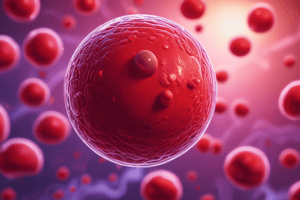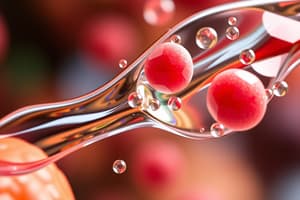Podcast
Questions and Answers
Red blood cells are also called?
Red blood cells are also called?
Red blood cells in an isotonic solution are?
Red blood cells in an isotonic solution are?
disc-shaped
Red blood cells put in a hypertonic solution will?
Red blood cells put in a hypertonic solution will?
shrivel and become crenated
Red blood cells put in a hypotonic solution will?
Red blood cells put in a hypotonic solution will?
Signup and view all the answers
Human erythrocytes function best in a(n)?
Human erythrocytes function best in a(n)?
Signup and view all the answers
Facilitated diffusion requires?
Facilitated diffusion requires?
Signup and view all the answers
Facilitated diffusion occurs?
Facilitated diffusion occurs?
Signup and view all the answers
Facilitated diffusion is used to transport?
Facilitated diffusion is used to transport?
Signup and view all the answers
Unlike simple diffusion, facilitated diffusion requires energy expenditure by the cell.
Unlike simple diffusion, facilitated diffusion requires energy expenditure by the cell.
Signup and view all the answers
Facilitated diffusion requires a specific transporter for a specific molecule.
Facilitated diffusion requires a specific transporter for a specific molecule.
Signup and view all the answers
Active transport can best be described as?
Active transport can best be described as?
Signup and view all the answers
The sodium-potassium pump requires a carrier protein that binds?
The sodium-potassium pump requires a carrier protein that binds?
Signup and view all the answers
The sodium-potassium pump requires ATP in order to create a change in the shape of the carrier protein.
The sodium-potassium pump requires ATP in order to create a change in the shape of the carrier protein.
Signup and view all the answers
Which of the following statements is true regarding the order and location of the movement of ions in the sodium-potassium pump?
Which of the following statements is true regarding the order and location of the movement of ions in the sodium-potassium pump?
Signup and view all the answers
Because more sodium ions are entering the cell than potassium ions leaving the cell, an electrical gradient occurs and a net negative charge develops outside the cell.
Because more sodium ions are entering the cell than potassium ions leaving the cell, an electrical gradient occurs and a net negative charge develops outside the cell.
Signup and view all the answers
The reactions that make up cellular respiration occur entirely within the mitochondria of cells.
The reactions that make up cellular respiration occur entirely within the mitochondria of cells.
Signup and view all the answers
The overall process of glycolysis is responsible for breaking down one glucose molecule into?
The overall process of glycolysis is responsible for breaking down one glucose molecule into?
Signup and view all the answers
The purpose of the preparatory reaction is to break down ________ into ________ so it can enter the citric acid cycle.
The purpose of the preparatory reaction is to break down ________ into ________ so it can enter the citric acid cycle.
Signup and view all the answers
The citric acid cycle is responsible for producing the bulk of the ATP generated during cellular respiration.
The citric acid cycle is responsible for producing the bulk of the ATP generated during cellular respiration.
Signup and view all the answers
Study Notes
Red Blood Cells (Erythrocytes)
- Red blood cells are known as erythrocytes.
- In an isotonic solution, erythrocytes maintain a disc-shaped structure.
- Exposure to a hypertonic solution causes erythrocytes to shrivel and become crenated.
- When placed in a hypotonic solution, erythrocytes undergo hemolysis and are destroyed.
- Human erythrocytes perform optimally in an isotonic environment.
Facilitated Diffusion
- This transport mechanism relies on carrier proteins to assist the movement of molecules.
- It can occur bidirectionally, depending on the concentration gradient of the transported molecule.
- Facilitated diffusion is crucial for transporting sugars and amino acids.
- Contrary to simple diffusion, facilitated diffusion does not require energy expenditure.
- It does require specific transporters for each molecule.
Active Transport
- Active transport involves the movement of molecules against their concentration gradient, from areas of lower concentration to higher concentration.
- The sodium-potassium pump is a prominent example, binding three sodium ions and two potassium ions.
- ATP is necessary for the sodium-potassium pump to alter the shape of the carrier protein.
- In the sodium-potassium pump, three sodium ions exit the cell, followed by the entry of two potassium ions.
Electrical Gradient
- An incorrect assertion suggests that more sodium ions enter the cell than potassium ions exit, leading to a net negative charge outside the cell; this is false.
Cellular Respiration
- It is false that cellular respiration reactions occur solely within mitochondria; some take place in the cytoplasm.
- Glycolysis breaks down one glucose molecule into one pyruvate and two ATP molecules.
- The preparatory reaction converts pyruvate into acetyl-CoA for entry into the citric acid cycle.
- The citric acid cycle does not generate the bulk of ATP produced during cellular respiration, which is a common misconception.
Studying That Suits You
Use AI to generate personalized quizzes and flashcards to suit your learning preferences.
Description
Test your knowledge on red blood cells, facilitated diffusion, and active transport mechanisms. Understand how erythrocytes respond to different solutions and the role of carrier proteins in transporting molecules across cell membranes. This quiz covers essential concepts in cell biology related to transport methods.




